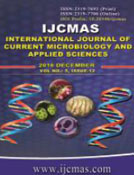


 National Academy of Agricultural Sciences (NAAS)
National Academy of Agricultural Sciences (NAAS)

|
PRINT ISSN : 2319-7692
Online ISSN : 2319-7706 Issues : 12 per year Publisher : Excellent Publishers Email : editorijcmas@gmail.com / submit@ijcmas.com Editor-in-chief: Dr.M.Prakash Index Copernicus ICV 2018: 95.39 NAAS RATING 2020: 5.38 |
To assess rates, bacteriological etiology and antimicrobial resistance patterns of the hospital acquired device-associated infection (DAI) in a medical/surgical intensive care unit (ICU). A prospective surveillance of DAI was conducted in the medical/surgical ICU, Emergency Hospital of Tanta University, Egypt, from 1st September 2015 to 1st March 2016, using the Centers for Disease Control and Prevention’s National Healthcare Safety Network case criteria for the different DAIs. In this study, the overall rate of DAI was 24.17 per 1,000 device-days. Ventilator-associated pneumonia (VAP) was the most common DAI (52.17/1,000 ventilator-days), followed by catheter-associated urinary tract infection (CAUTI) (11.63 /1,000 catheter-days) and central line-associated blood stream infection (CLABSI) (6.93/1,000 central line-days). The main cause of VAP was Klebsiella pneumoniae, and for CAUTI, it was Escherichia coli. In CLABSI, methicillin-sensitive Staphylococcus aureus and Staphylococcus epidermidis were equally presented. Overall, 92.68% of the isolated organisms in our study were multi-drug resistant. Gram-negative isolates showed highest resistance against the third generation cephalosporins (68.29% for each), followed by sulphamethoxazole / trimethoprime (63.41%), and the least was against imipenem (12.2%). Oxacillin resistance was 60% among the Gram-positive isolates. Routine microbiological surveillance are urgently needed to guide optimizing control measures and providing an obligating antimicrobial policy to prevent the high spread of multi-drug resistant infections in ICUs.
 |
 |
 |
 |
 |